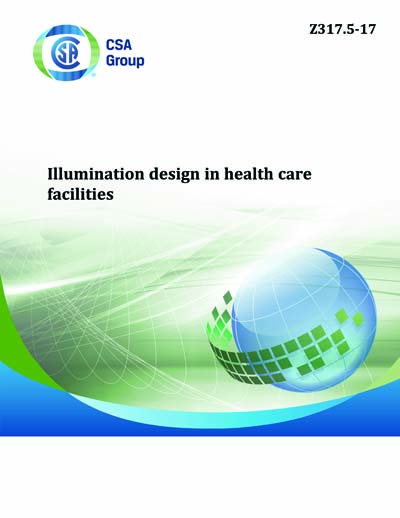Historical
CSA Z317.5-2017
Z317.5-17 - Illumination design in health care facilities
Preface
This is the third edition of CSA Standard Z317.5, Illumination design in health care facilities, and it supersedes the previous editions published in 1998 and 1989. It is one of a series of Standards that establishes criteria for the development of a health-promoting environment in health care facilities. Illumination design in health care facilities must serve many purposes. The system as a whole, and its subsystems, must provide suitable illumination for many diverse tasks which have varying degrees of importance. It must be integrated with a variety of space usages; it must contribute to safety; and it must be efficient, low in maintenance, and able to serve a facility that might operate 24 h a day, 365 days a year. Two major factors govern adequate illumination in each area and for each activity in the health care facility: a) the quality of the illumination, i.e., the colour rendition and the distribution of luminance; and b) the quantity of illumination. It is recognized that age influences the suitability of lighting levels in the performance of tasks. The mean age within Canadian health care facilities is rising, resulting in the need for higher lighting levels. The lighting levels in this Standard have been specified based on a minimum user population age of 55. It is recognized that this can lead to an increase in energy consumption. Where appropriate and with proper consultation, the lighting levels may be modified to suit individual needs. This Standard has been written for as wide an audience as possible, including designers, consultants, health care facility administration, and engineering departments. Every effort has been made not to restrict the application of new technologies within the health care facility. However, proper evaluation of new technologies prior to implementation is needed to ensure overall safety. This Standard is not intended to be used as a textbook on lighting. The IES Lighting Handbook and other similar materials, courses, and seminars are recommended for this purpose. CSA Group acknowledges that the development of the third edition of this Standard was made possible, in part, by the financial support of the governments of Alberta, British Columbia, Manitoba, New Brunswick, Newfoundland and Labrador, Northwest Territories, Nova Scotia, Nunavut, Ontario, Prince Edward Island, Québec, Saskatchewan, and Yukon as administered by the Canadian Agency for Drugs and Technologies in Health (CADTH).Scope
1.1 This Standard provides specific design criteria for illumination in various locations within a health care facility. Note: Lighting is both an art and a science. The basic technical criteria given in this Standard are not intended to inhibit creative design, but rather to ensure that minimum requirements are met. 1.2 This Standard deals with a) illumination sources; b) luminaires; c) illumination levels (see Table 1); and d) guidelines for specific areas and tasks. 1.3 This Standard does not deal with a) therapeutic illumination devices (e.g., phototherapy lamps); and b) special purpose devices such as UV sources for sterilization. 1.4 This Standard addresses requirements for illumination design. However, it is not meant to remove the need for consultation with users regarding specific or unusual requirements. 1.5 The requirements in this Standard are intended to be subordinate to applicable Provincial, Federal, or local regulatory authorities. 1.6 In this Standard, shall is used to express a requirement, i.e., a provision that the user is obliged to satisfy in order to comply with the standard; should is used to express a recommendation or that which is advised but not required; and may is used to express an option or that which is permissible within the limits of the Standard. Notes accompanying clauses do not include requirements or alternative requirements; the purpose of a note accompanying a clause is to separate from the text explanatory or informative material. Notes to tables and figures are considered part of the table or figure and may be written as requirements. Annexes are designated normative (mandatory) or informative (non-mandatory) to define their application.Content Provider
CSA America, Inc. [csa]






